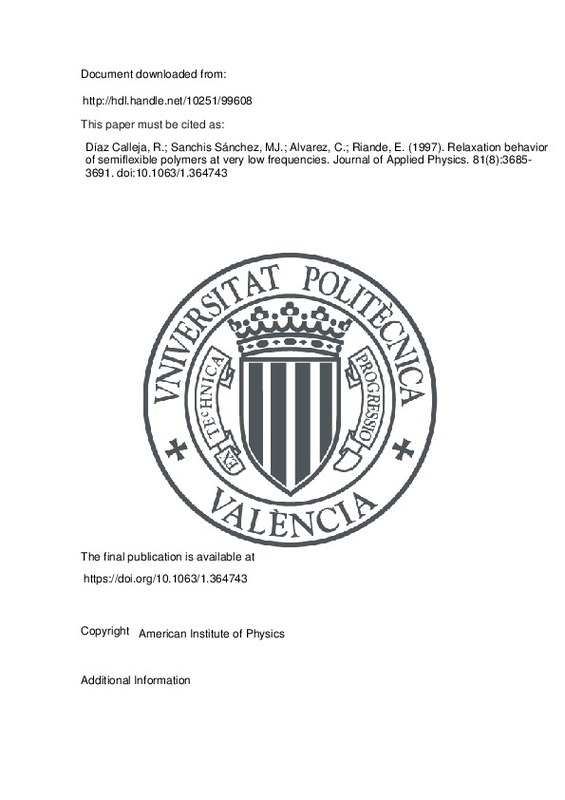JavaScript is disabled for your browser. Some features of this site may not work without it.
Buscar en RiuNet
Listar
Mi cuenta
Estadísticas
Ayuda RiuNet
Admin. UPV
Relaxation behavior of semiflexible polymers at very low frequencies
Mostrar el registro sencillo del ítem
Ficheros en el ítem
| dc.contributor.author | Díaz Calleja, Ricardo
|
es_ES |
| dc.contributor.author | Sanchis Sánchez, María Jesús
|
es_ES |
| dc.contributor.author | Alvarez, C.
|
es_ES |
| dc.contributor.author | Riande, E.
|
es_ES |
| dc.date.accessioned | 2018-03-23T05:12:55Z | |
| dc.date.available | 2018-03-23T05:12:55Z | |
| dc.date.issued | 1997 | es_ES |
| dc.identifier.issn | 0021-8979 | es_ES |
| dc.identifier.uri | http://hdl.handle.net/10251/99608 | |
| dc.description.abstract | [EN] The dielectric activity of poly(monocyclohexylmethylene itaconate) (PMCI) and poly(dicyclohexylmethylene itaconate) (PDCI) in the glassy region and in the glass-rubber transition is studied by thermostimulated discharge current (TSDC) techniques. The spectra obtained by global TSDC experiments show a prominent alpha-glass-rubber relaxation peak with maxima located at 97 and 55 degrees C for PMCI and PDCI, respectively, following in decreasing order of temperature for a well developed beta absorption and a comparatively low intensity relaxation. Better resolution of the relaxation behavior of these polymers in the glassy region is obtained by calculating the components of the complex dielectric permittivity epsilon* at extremely low frequencies from partial TSDC experiments. The ac spectra thus obtained suggest that the beta absorption is composed by two relaxations, each of them presumably associated with the motions of a side group. The differences observed in these spectra with those reported for the beta mechanical relaxation reported for these polymers in the literature are interpreted in terms of the restrictions that the side groups produce in the conformational space of phase of the backbone. These restrictions also explain the small changes in enthalpy in the glass-rubber transition which preclude the possibility of obtaining the glass-rubber transition temperature of these polymers by differential scanning calorimetric techniques. (C) 1997 American Institute of Physics. | es_ES |
| dc.language | Inglés | es_ES |
| dc.publisher | American Institute of Physics | es_ES |
| dc.relation.ispartof | Journal of Applied Physics | es_ES |
| dc.rights | Reserva de todos los derechos | es_ES |
| dc.subject.classification | MAQUINAS Y MOTORES TERMICOS | es_ES |
| dc.title | Relaxation behavior of semiflexible polymers at very low frequencies | es_ES |
| dc.type | Artículo | es_ES |
| dc.identifier.doi | 10.1063/1.364743 | es_ES |
| dc.rights.accessRights | Abierto | es_ES |
| dc.contributor.affiliation | Universitat Politècnica de València. Departamento de Termodinámica Aplicada - Departament de Termodinàmica Aplicada | es_ES |
| dc.description.bibliographicCitation | Díaz Calleja, R.; Sanchis Sánchez, MJ.; Alvarez, C.; Riande, E. (1997). Relaxation behavior of semiflexible polymers at very low frequencies. Journal of Applied Physics. 81(8):3685-3691. doi:10.1063/1.364743 | es_ES |
| dc.description.accrualMethod | S | es_ES |
| dc.relation.publisherversion | https://doi.org/10.1063/1.364743 | es_ES |
| dc.description.upvformatpinicio | 3685 | es_ES |
| dc.description.upvformatpfin | 3691 | es_ES |
| dc.type.version | info:eu-repo/semantics/publishedVersion | es_ES |
| dc.description.volume | 81 | es_ES |
| dc.description.issue | 8 | es_ES |
| dc.relation.pasarela | S\15266 | es_ES |








![[Cerrado]](/themes/UPV/images/candado.png)

